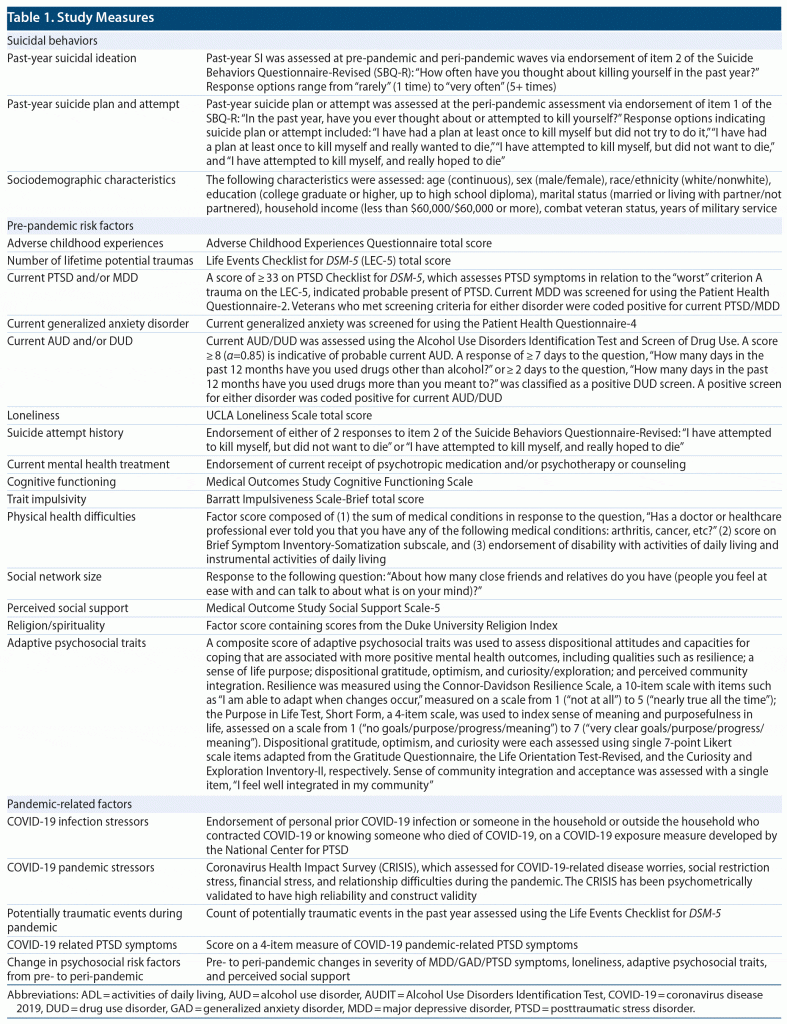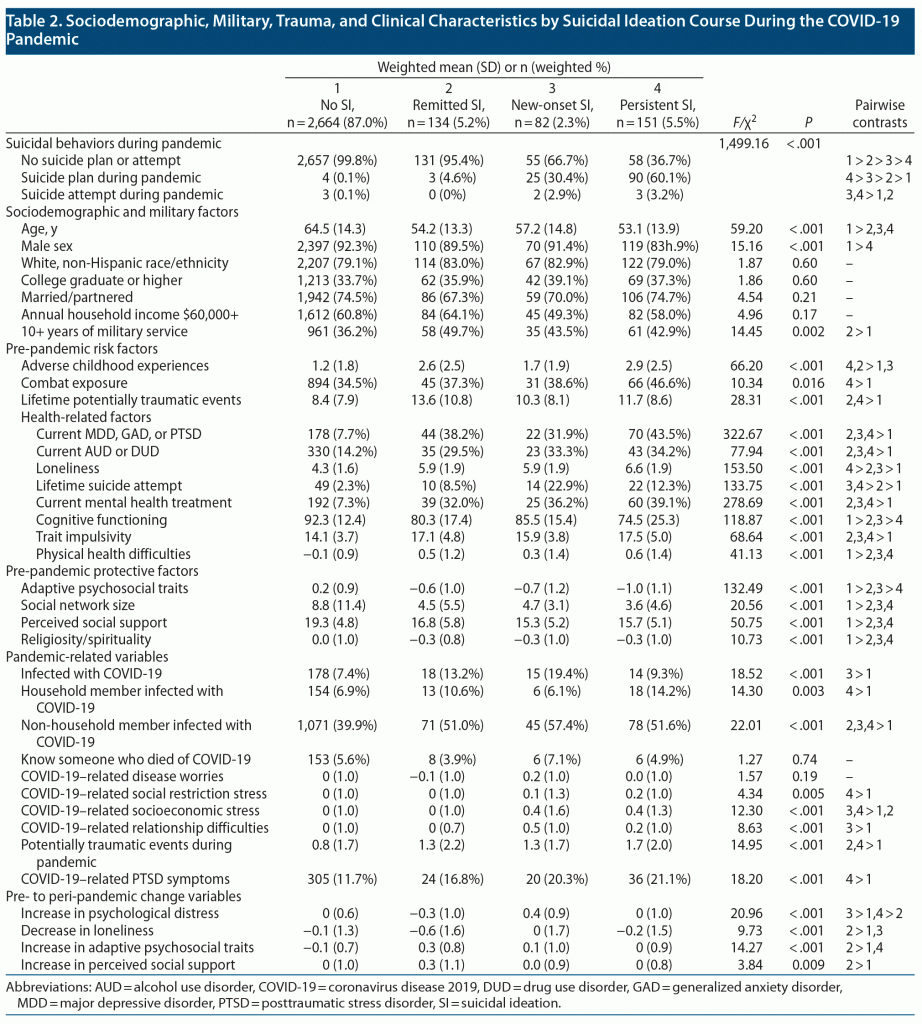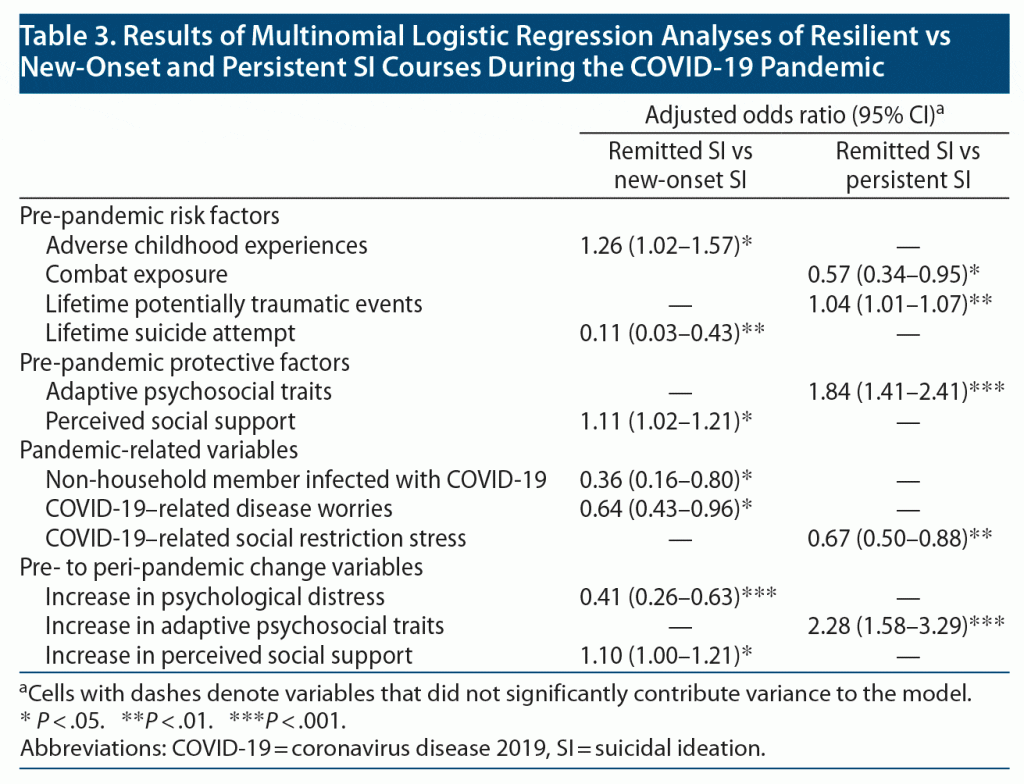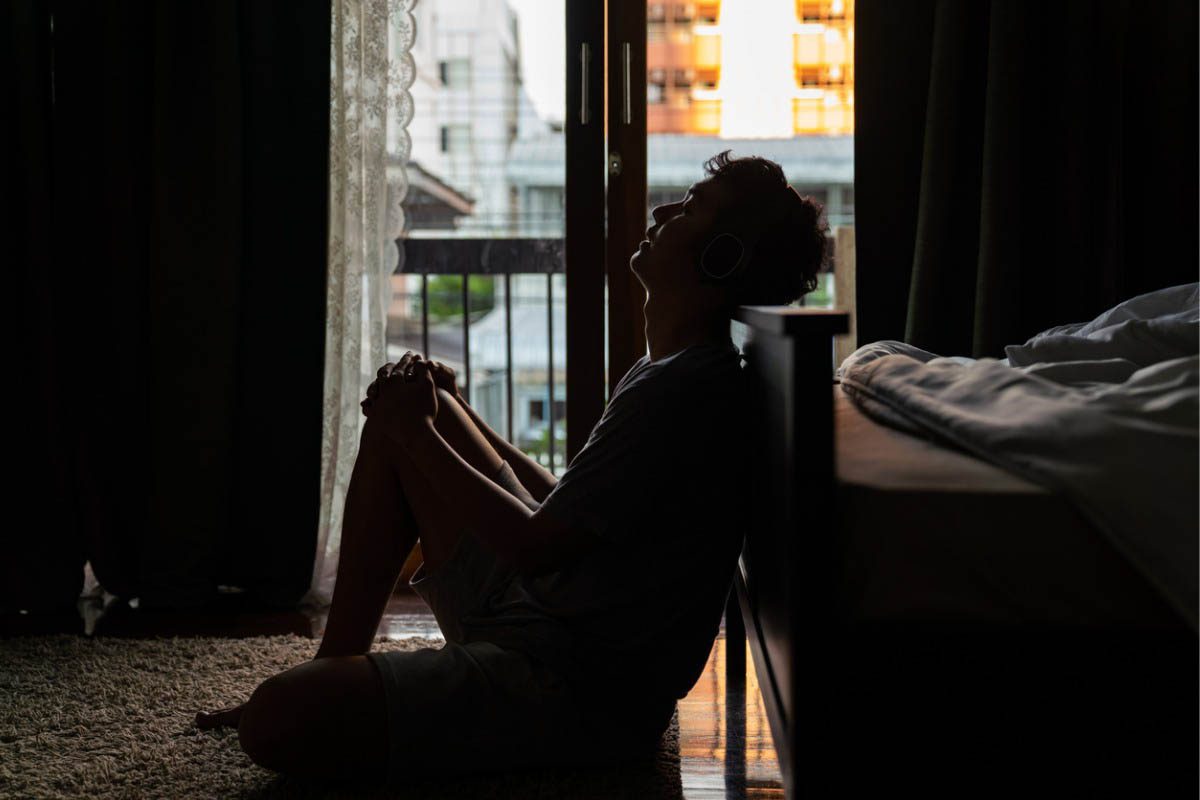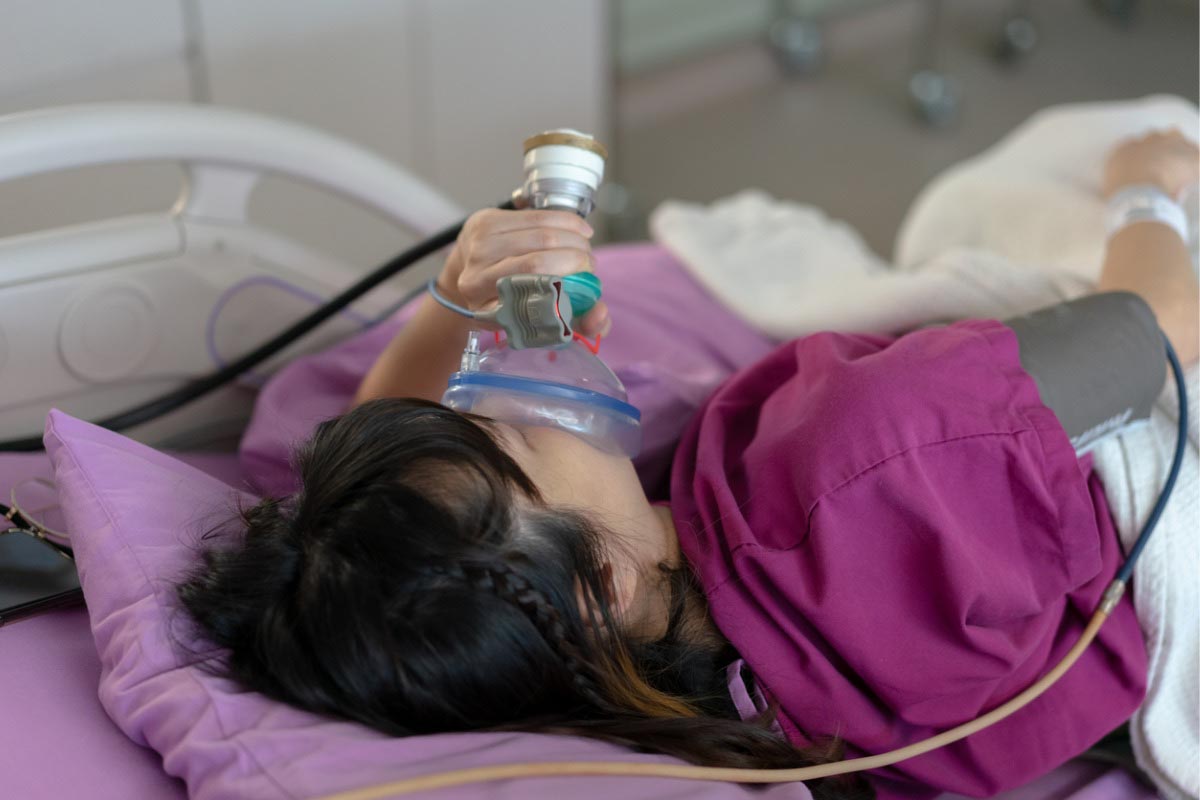
J Clin Psychiatry 2022;83(4):21br14341
To cite: Herzog S, Nichter B, Hill ML, et al. Factors associated with remission of suicidal ideation during the COVID-19 pandemic: a population-based, longitudinal study in US military veterans. J Clin Psychiatry. 2022;83(4):21br14341.
To share: https://doi.org/10.4088/JCP.21br14341
© 2022 Physicians Postgraduate Press, Inc.
aDepartment of Psychiatry, Columbia University Irving Medical Center, Columbia University, New York, New York
bDivision of Molecular Imaging and Neuropathology, New York State Psychiatric Institute, New York, New York
cDepartment of Psychiatry, Yale School of Medicine, New Haven, Connecticut
dDepartment of Psychiatry, University of California, San Diego, La Jolla, California
eVA San Diego Healthcare System, San Diego, California
fPsychiatry Service, VA Connecticut Healthcare System, West Haven, Connecticut
gNational Center for PTSD, White River Junction, Vermont
hVA Center of Excellence for Stress and Mental Health, San Diego, California
iUS Department of Veterans Affairs National Center for Posttraumatic Stress Disorder, VA Connecticut Healthcare System, West Haven, Connecticut
jDepartment of Social and Behavioral Sciences, Yale School of Public Health, New Haven, Connecticut
*Corresponding author: Sarah Herzog, PhD, 1051 Riverside Dr, Unit 42, New York, NY 10032 ([email protected]).
The COVID-19 pandemic, first declared a global public health emergency by the World Health Organization (WHO) on January 30, 2020,1 has resulted in profound social and economic hardship and over 5 million deaths worldwide as of October 2021.2 Scholars have forecast a secondary crisis of mental illness and suicidality extending far beyond those sickened by the virus3–6 as individuals struggle to cope with financial losses, fear of infection, uncertainty about the future, and unprecedented disruptions to their daily lives. However, it is difficult to accurately anticipate the mental health repercussions of COVID-19 without accounting for protective or mitigating factors that may confer resilience to adversity or promote remission of suicidal ideation (SI). Indeed, nearly 2 years since the WHO’s declaration, early data suggest that the COVID-19 pandemic has wrought heterogeneous mental health impacts7,8 and that the projected increase in suicidality has borne out in some populations more than in others.9–11
In their review of mental health sequelae following ecological disasters, Morganstein and Ursano12 suggested that suicidal thoughts and behaviors tend to diminish in the early aftermath, likely reflecting the buoying effect of community support and human capacity for posttraumatic growth,13 before gradually increasing in later months and years as these protective factors erode. Consistent with this conceptualization, a review of global population-level studies found evidence of considerable resilience to the psychological effects of lockdown during COVID-19 and no evidence of increased suicide rates.10 However, conflicting evidence suggests that rates of suicidal ideation and behavior have indeed increased during the pandemic, but perhaps unevenly across time and subpopulations.8 For example, a study conducted in Japan7 found a decline in suicide rates in the first 5 months of the pandemic, followed by an above-average increase in suicide in the subsequent 5 months, particularly among women, adolescents, and children. This is consistent with meta-analytic reviews of prior infectious disease outbreaks14 that indicate that certain populations (eg, older adults, disenfranchised or low-income individuals, those with preexisting psychiatric conditions) may be more vulnerable to increases in suicidality during this time than others.
One population vulnerable to increased suicide rates is US military veterans, whose rates of mental illness and suicide far exceed those of the general population. Despite their vulnerability, however, a recent longitudinal study of 3,078 US veterans assessed both prior to and during the pandemic found that SI decreased from pre- to peri-pandemic.15 Further, a substantial proportion of veterans in this cohort demonstrated resilience to COVID-19–related increases in psychological distress, and this was predicted by adaptive psychosocial factors such as pre-pandemic social connectedness and secure attachment style.16 Despite accumulating evidence of psychological resilience and decreases in SI during the pandemic, no known study has longitudinally examined factors associated with remission of SI. In the current study, we compared veterans with and without remission of SI during the pandemic (defined as endorsement of SI before but not during the pandemic) on pre- and peri-pandemic clinical and psychosocial characteristics to identify factors related to remission of SI.
METHODS
Sample
The National Health and Resilience in Veterans Study (NHRVS) is a nationally representative survey of US veterans. A total of 4,069 veterans completed a Wave 1 pre-pandemic (median completion date: November 21, 2019) survey prior to the first documented COVID-19 case in the US, and 3,078 completed a Wave 2 peri-pandemic follow-up assessment 1 year later (median completion date: November 14, 2020). A total of 7,860 veterans were invited to participate in the study, and 4,069 completed Wave 1 (51.8% participation rate); of these 4,069 veterans, 3,929 (96.6%) remained in the survey panel when the follow-up survey was launched and 3,078 completed the follow-up survey (78.3% participation rate and 75.6% of the baseline cohort). All participants provided informed consent, and the study was approved by the Human Subjects Subcommittee of the VA Connecticut Healthcare System.
The NHRVS sample was drawn from KnowledgePanel, a research panel of more than 50,000 households that is maintained by Ipsos, a survey research firm. KnowledgePanel is a probability-based, online non-volunteer access survey panel of a nationally representative sample of US adults that covers approximately 98% of US households. Panel members are recruited through national random samples, originally by telephone and now almost entirely by postal mail. Households are provided with access to the Internet and computer hardware if needed. KnowledgePanel recruitment uses dual sampling frames that include both listed and unlisted telephone numbers, telephone and non-telephone households, and cell-phone–only households, as well as households with and without Internet access.
To permit generalizability of study results to the entire population of US veterans, the Ipsos statistical team computed post-stratification weights using the following benchmark distributions of US military veterans from the most recent (August 2019) Current Veteran Population Supplemental Survey of the US Census Bureau’s American Community Survey17: age, gender, race/ethnicity, Census region, metropolitan status, education, household income, branch of service, and years in service. An iterative proportional fitting (raking) procedure was used to produce the final post-stratification weights.
Veterans who endorsed past-year SI at the pre-pandemic assessment but denied SI at the peri-pandemic follow-up were characterized as remitted, while veterans who denied pre-pandemic SI but reported SI at follow-up were characterized as having new-onset SI. Veterans who endorsed SI at both assessments were characterized as having persistent SI.
Assessments
Details regarding assessment instruments are provided in Table 1 (assessment references included in Supplementary Material).
Data Analysis
Baseline characteristics of SI courses were compared with bivariate tests (Table 2), and variables associated with SI groups at the P < .05 level were entered into a multinomial logistic regression with backward elimination estimation to identify pre- and peri-pandemic factors associated with (1) remitted SI vs new-onset SI and (2) remitted SI vs persistent SI. Relative importance analyses were conducted to compare the relative variance explained (RVE) in remitted SI by each significant variable.
RESULTS
The prevalence of remitted SI, new-onset SI, and persistent SI was 5.2%, 2.3%, and 5.5%, respectively. Of the 2,746 veterans without SI at the pre-pandemic assessment, 82 (2.6%) developed SI during the pandemic. Of the 285 veterans with pre-pandemic SI, 134 (48.6%) denied SI during the pandemic.
Remitted SI vs New-Onset SI
Relative to veterans with new-onset SI, remitted veterans reported less exacerbation of psychological distress during the pandemic (RVEs = 55.5%), were less likely to report a prior suicide attempt (RVE = 17.2%) and reported greater increases in social support (RVE = 12.7%). They also reported fewer COVID-19 disease-related worries (RVE = 6.0%), more adverse childhood experiences (RVE = 5.8%), greater pre-pandemic social support (RVE = 2.0%), and lower likelihood of knowing someone infected with COVID-19 (RVE = 0.9%).
Remitted SI vs Persistent SI
Relative to veterans with persistent SI, remitted veterans scored higher on measures of pre-pandemic purpose in life (RVE = 36.0%) and reported greater increases in purpose in life during the pandemic (RVEs = 20.3%). They also reported lower stress resulting from pandemic-related social distancing (RVE = 14.9%) and more pre-pandemic potentially traumatic events (RVE = 12.6%), were less likely to be a combat veteran (RVE = 9.6%), and reported greater pre- to peri-pandemic increases in perceived resilience (RVE = 6.6%). See Table 3 for odds ratios of group comparisons.
DISCUSSION
This population-based prospective cohort study examined factors associated with remission of SI during the COVID-19 pandemic in US military veterans. SI remission—defined as endorsement of SI prior to but not during pandemic—was nearly 19 times more prevalent than peri-pandemic new-onset SI (48.6% vs 2.6%). This is consistent with prior work in non-veteran samples10 indicating stable or decreasing SI during the early stages of the pandemic and suggests that, contrary to expectations, SI remission during the pandemic is prevalent even in vulnerable populations such as military veterans.
Several variables distinguished veterans with remitted SI from veterans with persistent or new-onset SI. Pre-pandemic purpose in life accounted for the largest proportion of explained variance in SI remission relative to persistent SI (36.0%, OR = 1.84, 95% CI = 1.41–2.41), while pre- to peri-pandemic increases in purpose in life and perceived resilience accounted for a collective 27% of explained variance (OR = 2.28, 95% CI = 1.58–3.29). Purpose in life has been linked to healthy coping behaviors and reduced stress reactivity18 and may help confer remission of SI by encouraging more adaptive regulation of negative emotions. Lower distress related to social distancing restrictions was also associated with SI remission relative to persistent SI, albeit with a smaller effect (OR = 0.67, 95% CI = 0.50–0.88). Potentially, lower distress may reflect more effective coping, or higher distress tolerance, in the remitted group. Alternatively, veterans with remitted SI may have been better able to maintain interpersonal connections during periods of social distancing. Notably, the aforementioned factors associated with SI remission—social connectedness and purpose in life—have been found to be integral to fostering general psychological well-being, resilience, and adaptability19 and may be modifiable using psychological interventions and skills-based training.20,21
Several prominent risk factors for suicidal thoughts and behaviors were not predictive of a lower likelihood of SI remission, including psychiatric diagnosis (major depressive disorder, generalized anxiety disorder, posttraumatic stress disorder, alcohol/substance use disorders). Null effects for psychopathology may reflect the fact that the 3 SI groups did not differ from each other in their rates of psychiatric diagnoses. Nonetheless, veterans with remitted SI reported less exacerbation of psychological distress during the pandemic relative to veterans who developed SI (OR = 0.41, 95% CI = 0.26–0.63), and this explained the largest proportion of variance in SI remission relative to new-onset SI (RVE 55%). These findings suggest that clinical monitoring and intervention for intensification of distress may help promote SI remission during times of crisis and that worsening of mental health status during this period may be a significant risk factor for SI.
Limitations of this study include the relative homogeneity of the sample with respect to gender, race, ethnicity, and shared military experience, which restricts the degree to which data can be generalized to more diverse samples. Additionally, the limited number of follow-up assessments prevent a more granular depiction of shifts in SI during the COVID-19 pandemic. Nevertheless, our findings highlight the potential clinical utility of monitoring changes in psychological distress during the pandemic, as well as enhancing adaptive characteristics such as purpose in life and perceived resilience to help mitigate SI. Ongoing assessment of pandemic-related mental health sequalae in veterans and other at-risk populations is necessary to understand the continued impact of protective factors on suicide-related outcomes as the COVID-19 pandemic progresses.
Published online: June 27, 2022.
Relevant financial relationships: None.
Funding/support: The National Health and Resilience in Veterans Study is supported by the US Department of Veterans Affairs National Center for Posttraumatic Stress Disorder.
Role of the sponsor: The funding source had no role in the design, analysis, interpretation, or publication of this study.
Supplementary material: Available at Psychiatrist.com.
References (21)

- WHO. Statement on the Second Meeting of the International Health Regulations (2005) Emergency Committee Regarding the Outbreak of Novel Coronavirus (2019-nCoV). January 31, 2020. https://www.who.int/news/item/30-01-2020-statement-on-the-second-meeting-of-the-international-health-regulations-(2005)-emergency-committee-regarding-the-outbreak-of-novel-coronavirus-(2019-ncov)
- Johns Hopkins University & Medicine. Maps and Trends: Mortality Analyses. https://coronavirus.jhu.edu/data/mortality. 2021. Retrieved October 20, 2021.
- Sher L. The impact of the COVID-19 pandemic on suicide rates. QJM. 2020;113(10):707–712. PubMed CrossRef
- Banerjee D, Kosagisharaf JR, Sathyanarayana Rao TS. The “dual pandemic” of suicide and COVID-19: a biopsychosocial narrative of risks and prevention. Psychiatry Res. 2021;295:113577. PubMed
- Serafini G, Parmigiani B, Amerio A, et al. The psychological impact of COVID-19 on the mental health in the general population. QJM. 2020;113(8):531–537. PubMed CrossRef
- Reger MA, Stanley IH, Joiner TE. Suicide mortality and coronavirus disease 2019—a perfect storm? JAMA Psychiatry. 2020;77(11):1093–1094. PubMed CrossRef
- Tanaka T, Okamoto S. Increase in suicide following an initial decline during the COVID-19 pandemic in Japan. Nat Hum Behav. 2021;5(2):229–238. PubMed CrossRef
- Dubé JP, Smith MM, Sherry SB, et al. Suicide behaviors during the COVID-19 pandemic: a meta-analysis of 54 studies. Psychiatry Res. 2021;301:113998. PubMed CrossRef
- Appleby L. What has been the effect of COVID-19 on suicide rates? BMJ. 2021;372:n834. PubMed CrossRef
- Prati G, Mancini AD. The psychological impact of COVID-19 pandemic lockdowns: a review and meta-analysis of longitudinal studies and natural experiments. Psychol Med. 2021;51(2):201–211. PubMed CrossRef
- Pirkis J, John A, Shin S, et al. Suicide trends in the early months of the COVID-19 pandemic: an interrupted time-series analysis of preliminary data from 21 countries. Lancet Psychiatry. 2021;8(7):579–588. PubMed CrossRef
- Morganstein JC, Ursano RJ. Ecological disasters and mental health: causes, consequences, and interventions. Front Psychiatry. 2020;11:1. PubMed CrossRef
- Kessler RC, Galea S, Jones RT, et al; Hurricane Katrina Community Advisory Group. Mental illness and suicidality after Hurricane Katrina. Bull World Health Organ. 2006;84(12):930–939. PubMed CrossRef
- Zortea TC, Brenna CT, Joyce M, et al. The impact of infectious disease-related public health emergencies on suicide, suicidal behavior, and suicidal thoughts. Crisis. 2021;42(6):474–487. PubMed
- Nichter B, Hill ML, Na PJ, et al. Prevalence and trends in suicidal behavior among US military veterans during the COVID-19 pandemic. JAMA Psychiatry. 2021;78(11):1218–1227. PubMed CrossRef
- Hill ML, Nichter B, Na PJ, et al. Mental health impact of the COVID-19 pandemic in U.S. military veterans: a population-based, prospective cohort study. Psychol Med. 2021:1–12. PubMed CrossRef
- US Census Bureau. The American Community Survey. https://www2.census.gov/programs-surveys/acs/methodology/questionnaires/2019/quest19.pdf. 2019. Retrieved November 1, 2021.
- Schaefer SM, Morozink Boylan J, van Reekum CM, et al. Purpose in life predicts better emotional recovery from negative stimuli. PLoS One. 2013;8(11):e80329. PubMed CrossRef
- Dahl CJ, Wilson-Mendenhall CD, Davidson RJ. The plasticity of well-being: a training-based framework for the cultivation of human flourishing. Proc Natl Acad Sci U S A. 2020;117(51):32197–32206. PubMed CrossRef
- Heisel MJ, Flett GL. Do Meaning in Life and Purpose in Life Protect Against Suicide Ideation Among Community-Residing Older Adults? Meaning in Positive and Existential Psychology. Springer; 2014:303–324.
- O’Rourke HM, Collins L, Sidani S. Interventions to address social connectedness and loneliness for older adults: a scoping review. BMC Geriatr. 2018;18(1):214. PubMed CrossRef
This PDF is free for all visitors!
